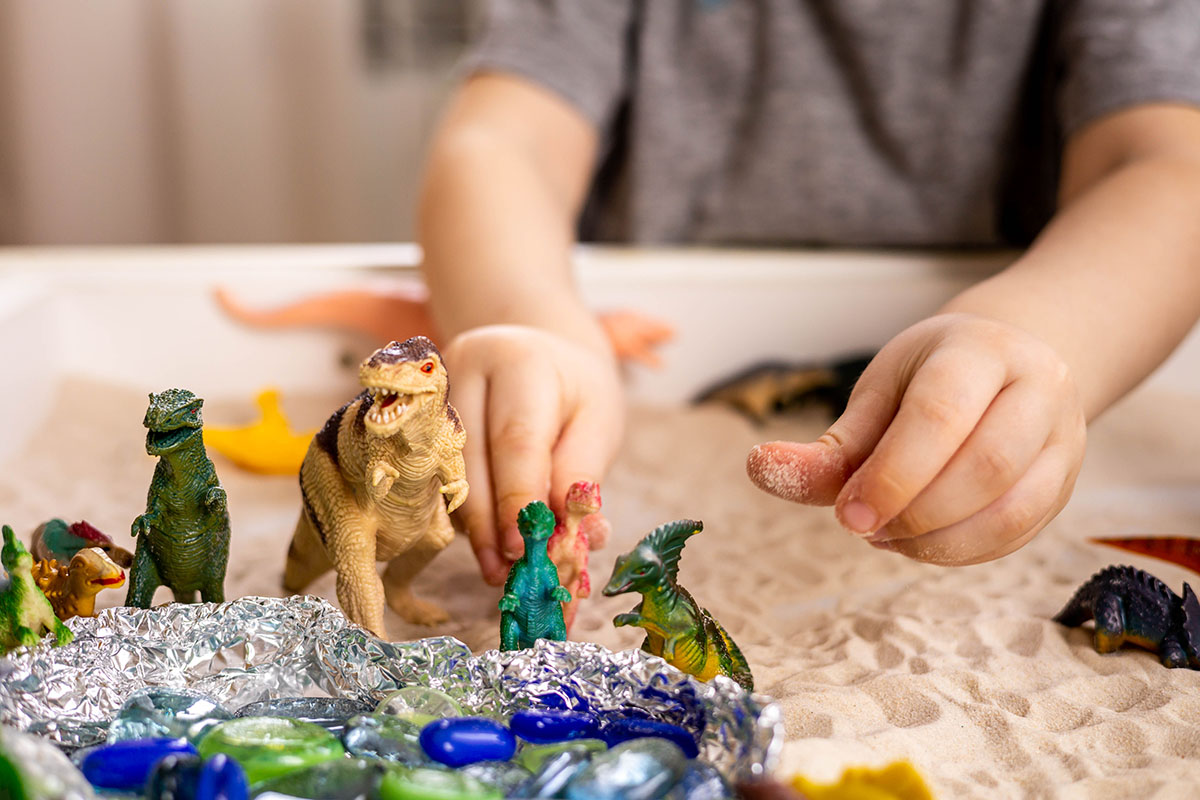What is sandtray therapy?
Sandtray therapy is a therapeutic modality that uses the power of images and symbols to help clients heal and meet their treatment goals and life goals. It uses miniature figurines and a tray of sand to help clients explore their inner world, work through patterns problems in their lives, and heal from past and current wounds. Sandtray therapy facilitates storytelling. It helps clients turn pictures into words and to identify, explore, and share what is buried in the client. It brings the unconscious and conscious together through images and symbols. This type of therapy also helps create a safe distance between the client and their trauma or issues while they work with their therapist.

What are the benefits of sandtray therapy?
Images are powerful. They can help us access parts of the brain and our inner world that sometimes we can’t express through words. Working with the sand and figurines allows the client to delve deeper into their inner world, allowing access to what is in the subconscious. What is revealed can then be processed and healed.
This modality gives clients another medium for healing. Clients can find forward movement where previously they may have been stuck. Sandtray therapy facilitates healing, deeper insight and understanding, and resolutions to life’s difficulties.
Who is sandtray therapy for?
Sandtray therapy is not just for children! It has been shown to benefit a variety of emotional, behavioral, and relationship issues in clients ages four to elderly. ECRC therapist Dawn Lamprecht uses sandtray therapy with children ages four and up, individual adults, teens, families, couples, and in parent coaching sessions. Clients are never forced to try this therapy; rather, Dawn uses this therapy in sessions in accordance with the needs and preferences of the client.

How did sandtray therapy come about?
Sandtray therapy was created in 1929 by Margaret Lowenfeld to help children with PTSD from the war. Dr. Lowenfield found that providing a tray of sand and small objects helped the children put their thoughts and feelings into scenes of images where they could work through their issues and communicate their experiences without words. But sand has been used for hundreds of years in soothing and regulating people. This therapy is cross-theoretical; it can be used with any therapeutic model.
(Note: Sandplay therapy, unlike sandtray therapy, is a modality which specifically uses Jungian theory as developed by Dora Kalff. This article references only sandtray therapy, excluding sandplay therapy, which follows it’s own guidelines, modality, and professional certifications. Our therapist at ECRC uses sandtray therapy, and does not use sandplay therapy.)
How does sandray therapy work?
Because of its use of images, sandtray therapy can bring up things that remain deeply buried, even in talk therapy. Things like attachment wounds, trauma, and losses can be complex and devastating. Using images and symbols can help the client safely release, work through, and resolve areas in their lives where they previously felt stuck. Sandtray therapy is about changing perspective as well as working through things. When we see with our eyes visually what is in the sandtray, and use our hands to place and move the objects, what our brain had not processed can now help us also see and build resolutions to our issues which were not previously clear. The symbolic nature of the work mimics the symbolic way we first learn our world; through images, textures, and physical and visual exploration. Research has show that expressive therapies, including sandtray therapy, reconnect us with different parts of the brain, enacting parts of the brain and helping us rebuild and reconnect new patterns and neuropathways in the brain. Simplified: we can show in the sandtray through images and symbols what is difficult to express in words, and it can help us holistically at the same time!

What is involved?
Sandtray therapy starts with a tray of sand and a collection of miniature figurines. The client chooses miniatures and places them in the sandtray. Sometimes the client has a choice of sandtrays, type of sand, and different sand colors. Sometimes clients can add water to the sand. The sand itself supports the miniature objects, and allows for movement of the objects in the sandtray. (Sometimes client just need to regulate in the sand, without building a scene in the sand. The therapist can lead the client to self-soothe with just the sand, or the sand and a few objects for working with the sand.) When clients select figurines they are drawn to, they often don’t know the reasons for their selections. Each figurine selected could represent any number of meanings for them. When the client is satisfied with the objects they have chosen, called a build, the therapist can help the client process their build….their inner world.
What is the role of the therapist?
In sandtray therapy, the therapist helps the client process their build and helps them unfold the story before them. It is also the role of the therapist, just as in talk therapy, to provide a safe space for the client to process and share what they see about their lives from the scene they built in the sand. The therapist doesn’t interpret the client’s build; the therapist helps the client explore the scene and story they have shared.

ECRC’s Sandtray Therapist, Dawn Lamprecht
A trained sandtray therapist holds space for the client to feel safe as well as seen and understood as the client works with the medium. ECRC’s Dawn Lamprecht offers a vast array of sandtray figurine objects in all of the sandtray therapy categories. She also provides several types of trays and sands for the client to choose from based on their preferences and needs. Dawn Lamprecht has years of training and experience in using sandtray therapy with clients of all ages. When considering sandtray therapy, seek out a therapist with extensive training in using this modality. Dawn Lamprecht has received formal sandtray training through Mashall Lyles, Linda Homeyer, Dr. Terry Kottman, Jackie Flynn, Amy Flaherty Hood, and many other experts in this field, and she has also given sandtray trainings for other therapists. Dawn Lamprecht is a Registered Sandtray Therapist™ through the World Association for Sand Therapy Professionals (WASTP). She is also a member of WASTP. Dawn is also a member of the International Association for Sandtray Therapy.

